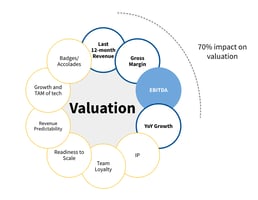Amongst the top attributes that drive ETS valuations, EBITDA is right up there with Growth rate,...
Setting Targets: The Art of Making Up Numbers For Real Outcomes

In previous posts: here and here, we talked about the importance of tech services founders in setting targets for their businesses. Setting the right target is extremely important for a fast-growing company. Every part of the business needs to change to accommodate the growth. A too-low target will cause our growth to slow down by not building the right capabilities. A too-high target will cause us to overspend and create a cash crisis.
As a business matures, the target-setting exercise becomes more manageable. You have more historical data and understand the various lever at your disposal. But working with the blank slate of an early-stage tech services startup is daunting. This article gives a set of thought processes that the founder of a tech services startup can use to create targets in the tumultuous early stages of their business.

Last Year's Growth Minus 20%
In the early days of founding your business, you'll find yourself doubling and tripling in size. It doesn't hurt to be aggressive if you are in this position. Although as you grow, it becomes harder to grow this fast. So assume a part of the growth rate is just from the small size, and you will not be able to maintain it.
Hence you should decrease the target by a modest 20%. Take the numbers from the same quarter in the previous year and multiply them with the growth rate times 0.8.

Stay The Course
If you're making significant organizational changes and don't have a history of high growth, then assuming immediate growth may put undue pressure on you. Instead, focus on stabilizing the business and getting early indicators from some of your experiments.
You would use this time to refine your value proposition, improve customer outcomes, and build a funnel for future growth. Accepting that it will be a few quarters before the revenue will change.

The Rule of 40
The rule of 40 https://www.wallstreetprep.com/knowledge/rule-of-40/ is a rule of thumb common among VCs and private equity in evaluating a good business. According to this rule, the sum of EBITDA (Earnings Before Interest, Taxes, Depreciation, and Amortization) and CAGR (Compound Annual Growth Rate) is greater than 40 for a good business.
The rule of 40 gives you an aggressive but achievable target that you can hit even after your company has reached a respectable scale. It also gives you a reality check on investments you take in.
Red Queen's Race


If you're in a rapidly growing market, you apply the "Red Queen's Race" rules. Growing at the same pace as the market would mean you are keeping pace with the world. Anything less is falling behind. The idea of not growing 100% as falling behind is a daunting take. But it is a measure of the opportunity available to you.
To harvest the full opportunity, you may need to take investment under the rule of 40. This should be expected because the platforms providing the fast-growing emerging technology are also getting funding to operate with negative EBITDA.

Bottom Up Forecast
You can also set your targets based on a bottom-up forecast. You extrapolate targets by counting the leads from your outreach campaigns. Building targets from the bottom up is extremely important when you have had early success with go-to-market experiments and need to operationalize and scale your results.
You may be leveraging the network from a previous life or had resounding success with a new messaging campaign that you want to double down on.
After reading through these options, you may wonder which process you should implement. The answer is all of them. Remember the Eisenhower quote: "Plans are worthless, planning is everything." Simulating what it means to create targets with each process will give you an understanding of your business and its constraints. Things will not go according to plan. You will miss your targets. That's okay. You will do better next quarter and the quarter after that. What's most vital is that you start now.



.png?height=200&name=Banners%20for%20Blog%20Strategy%20and%20Tactics%20%20(2).png)

